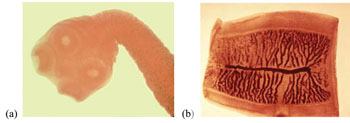38.2.1 Mode of transmission of taeniasis
Adult beef tapeworms of the species Taenia saginata can grow very large – they can reach a length of five metres within a few months of infecting a person, but some have been recorded at up to 25 metres! The tapeworm attaches to the inside of the intestine by four strong suckers in its tiny head (Figure 38.6a). The long flat body of the tapeworm is formed from between 1,000 to 2,000 sections called proglottids (Figure 38.6b). The proglottids near the end of the tapeworm mature and become capable of surviving for a time after detaching from the main body of the worm. When a mature proglottid breaks away from the adult worm, it can contain up to 100,000 eggs. Approximately six mature proglottids are passed in the person’s stool every day – shedding up to 600,000 eggs into the environment daily!

Proglottids of Taenia saginata passed in the faeces of an infected person onto grazing land, or used as fertiliser, are eaten by cows grazing on the same fields. The eggs hatch into larvae inside the cow’s intestine, and burrow out through the intestinal wall into the muscles, where they become trapped inside a wall of tissue that forms around them. This stage of the tapeworm’s lifecycle is called a cysticercus. Cysticercus (singular) is pronounced ‘siss-tee-surr-cuss’. The plural is cysticerci (‘siss-tee-surr-see’).Transmission to new human hosts occurs when the person eats raw or undercooked beef containing a cysticercus. The digestive enzymes in the person’s stomach and intestines digest the wall around the tiny immature tapeworm in the cysticercus, releasing it into the intestine, where it attaches to the intestinal wall by the four suckers shown in Figure 38.6(a). The tapeworm matures in the person’s intestine and begins to release proglottids, continuing the lifecycle.
38.2 Taeniasis (tapeworm infestation)
